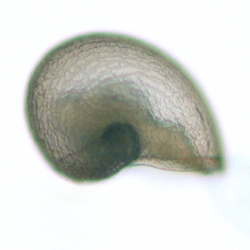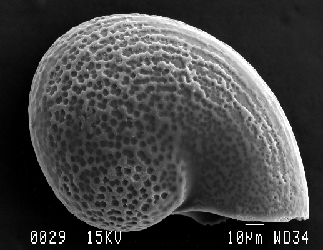

Also see:
Protoconch SEM Fig. 2 Mullineaux et al. 1996, Fig 10 Turner et al. 1985
Desbruyères et al. (2006) p. 86. right photo shows the larva, left shows a juvenile with the protoconch visible.
| Size under dissecting microscope: 175-180µm Size under compound microscope: 170µm |
| Morphology: Small protoconchs with coarse pitted sculpture in closely spaced rows, giving the effect of lineate sculpture. The aperture is slightly wavy, with a distinct medium-width rim visible under the compound microscope. |
| Frequency: Pump EPR 1999-2000: Occasional Pump EPR 2004: Frequent Trap EPR 2004-2005: Occasional |
Pointy apex is very similar to Clypeosectus delectus. It is possible that both protoconchs represent different forms of the same species (or possibly two species in the same genus), but because of consistent differences in their morphology, we have kept them separate for the present. The chief differences between the two groups are that the sculpture of C. delectus is coarser, the shape of the shell is more rounded and the aperture rim is wider. The protoconch of C. delectus is also slightly larger (175μm vs. 160μm) for pointy apex. In the picture at bottom, Clypeosectus is on the right; pointy apex on the left. |
|
Lepetodrilus spp. Approximately the same size as C. delectus. The distinguishing features are that in C. delectus the line of the aperture does not line up with the posterior portion of the shell, whereas in Lepetodrilus it forms a nearly straight line. The sculpture in Lepetodrilus is much finer and more widely spaced and usually doesn’t show any obvious lineation under the dissecting microscope. |
|
| Unknown 5. is about the same size as C. delectus, but as for Lepetodrilus, the aperture and the base form a nearly straight line. The narrow aperture rim flares out to the sides and at the outer edge. This species has reticulate, rather than pitted, sculpture. | |
| Gorgoleptis emarginatus (on left in top photo), Gorgoleptis spiralis (right in top photo) and Gorgoleptis sp. 3 (bottom). Two of the three presumed Gorgoleptis protoconchs we have found are approximately the same size as Clypeosectus and have similar sculpture. The chief distinction between the two genera is that Gorgoleptis protoconchs have a sharp point at the anterior edge of the aperture and two of the three species also have points on the sides, giving the aperture a scalloped appearance. If these points have been broken off, the curved remnants of the aperture rim can give a clue to their presence. | |
| Lepetodrilus-like. These are about 15-20μm larger than Clypeosectus delectus. Their sculpture is somewhat finer and does not show any lineation. Unlike Clypeosectus, their apertures more or less line up with their bases, though the apertures themselves may be slightly curved. They appear to lack an aperture rim. |
Go to:
Home
Gastropods by Size
Gastropods by Species
Other Taxa